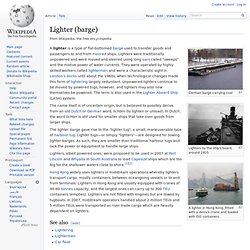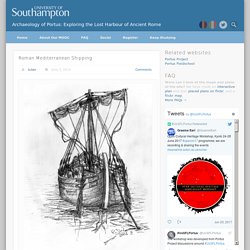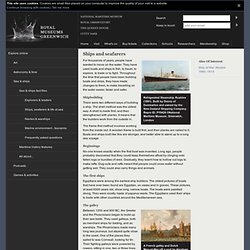

Building a War of 1812 Warship. Oliver Hazard Perry, the U.S naval officer who won a decisive victory against the Royal Navy on Lake Erie during the War of 1812—“We have met the enemy and they are ours,” he declared—would have appreciated the irony.

An extraordinary new sailing ship was supposed to be a replica of a British warship that his flotilla captured. But when the Canadian group behind the venture ran out of money, enthusiasts in Rhode Island bought the unfinished 138-foot-long steel hull and named it after Perry, an Ocean State native. Six years and more than $10 million later, the three-masted, 20-sail tall ship will launch this summer from the Newport Shipyard. And while it’s the first vessel of its kind to be built in the United States since 1903, it’s also fitted with 21st-century technology, such as twin six-cylinder backup engines. Imme Skinfaxe - Viking ship in Copenhagen. Photo: Hans Jørgensen Originally, it was the scouts of the Clan Heidrun of Frederiksværk, who built the Imme Skinfaxe.

The clan - among other goals - set about to test the theory that the trees used for the original ships were dug up instead of felled, as we do today. Therefore, the scouts set about digging up the roots of two large oak trees. The task required 5 -6 men’s work for a week... per tree! It needed four oaks to build the ship and all in all it required 12.000 working hours to build Imme Skinfaxe.
Sebbeenglish.pdf. Starting the Dialogue between Archaeologist and Boat Builder - Shipwrecks and Submerged Worlds. One of the things we are concerned with as maritime archaeologists is how ships were designed and constructed.

Even though ships are objects that are interesting to investigate from a technological point of view, they can also inform us about some less obvious aspects of the past. For example, by examining shipwrecks from the Roman period, we can learn about the design- and construction procedures the Romans used to build their ship which have been lost today. Furthermore, by synthesising the data of numerous excavated shipwrecks, archaeologists can track the development of shipbuilding technology through time.
This development in technology is an important manifestation of innovation, economical and social change in the past. The interpretation of shipwrecks can be a complicated matter and is often performed by specialists within the discipline (sometimes called ‘nautical archaeologists’). The next few days, it was time to put what we as experts write about into practice. Thomas Dhoop. Lighter (barge) German barge carrying coal Lighters by the ship's board, around 1925 A lighter in Hong Kong, fitted with a derrick crane and loaded with ISO containers The name itself is of uncertain origin, but is believed to possibly derive from an old Dutch or German word, lichten (to lighten or unload).

In Dutch, the word lichter is still used for smaller ships that take over goods from larger ships. Roman Mediterranean Shipping - Archaeology of Portus: Exploring the Lost Harbour of Ancient Rome. Some of the learners on the course have requested more information about the types of ships in the Roman Mediterranean.

The diverse ships and boats at Portus itself would have ranged from giant long-distance merchant ships, through vessels engaged in coastal trade, to small fishing boats capable of travelling only a few miles. MUSEET : THOR HEYERDAHLS FORSKNINGSSTIFTELSE. Hèracles viatja en la copa d'Hèlios (el Sol), c. 480 a.C., Musei Vaticani. Caballitos de Totora: Traditional Fishing in Peru. By Andrew Kolasinski.

Long before the first Europeans set foot on Peruvian beaches, local people had been harvesting the Pacific Ocean using ingenious boats constructed from readily available materials. This time-honored technique survives to this day, an ancient yet effective form of fishing in Peru. Caballitos de Totora, Huanchaco (photo © Roy & Danielle, Wikimedia Commons) Caballitos de Totora, Reed Boats of Peru In most of coastal Peru, reeds grow naturally and are planted and harvested as a construction material to build homes and shelters.
In the north of Peru, at Mancora and in communities near the Ecuadorian border, you will see a different type of fishing vessel. Caballitos remain a common and identifiable part of Peru’s coastal traditions. The Sheepskin Raft on the Yellow River - China culture. Www.bl.uk/onlinegallery/onlineex/apac/photocoll/i/zoomify56460.html. Sailing ship rig types. Cog. Bottom structure. Inner structure. Sails on a full-rigged ship. Cross section. Parts of a sailing rig. Shipbuilding Terms. A to C D to I J to M N to R S to Z.

Ship & Shipbuilding Terminology, complete terminology database listing. Cannon: An artillery gun made of bronze, or from the 16th century on more increasingly made of iron and usually mounted on a wheeled gun-carriage.

Early ship's cannons often resembled nothing more than a barrel strapped to a plank, later this 'plank' would develop into the full gun-carriage. Modern shipbuilding terms; : Pease, Fred Forrest, 1884- Ships and seafarers : Ships, seafarers & life at sea : Sea & ships fact files. Refrigerated Steamship Ruahine (1891).

Built by Denny of Dumbarton and owned by the New Zealand Shipping Company. Repro ID: PY0428 ©National Maritime Museum, Greenwich, LondonFor thousands of years, people have wanted to move on the water. They have used boats and ships to fish, to travel, to explore, to trade or to fight.